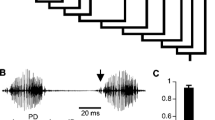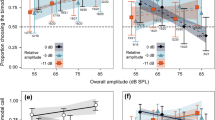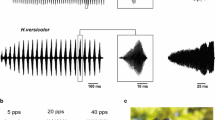Abstract
The selectivity of female phonotactic responses to synthetic advertisement calls was tested in choice situations. Preferences based on differences in the linear rise-time of synthetic pulses depended on intensity and carrier frequency. When the carrier frequency was 1.1 kHz, simulating the low-frequency peak in the advertisement call, females preferred alternatives with slower rise-time pulses that differed by 5 ms at playback levels of 75 dB SPL and higher. A rise-time difference of 10 ms was discriminated at 65 dB SPL. When the carrier frequency was 2.2 kHz, simulating the high-frequency peak in the call, females discriminated a 5-ms difference in rise-time only at 85 dB SPL. Females showed no preference when the difference was 10 ms at lower playback levels. The difference in the thresholds (about 15–20 dB) for discriminating differences in rise-time at the two carrier frequencies was greater than the difference in behavioral thresholds for these two frequencies (about 10 dB). This result suggests that rise-time discrimination can be mediated solely by the neural channel mainly tuned to the low-frequency peak in the call. Females probably assess differences in rise-time by comparing the first few pulses of each call rather than by averaging over the entire call.
Similar content being viewed by others
Author information
Authors and Affiliations
Additional information
Accepted: 30 March 1999
Rights and permissions
About this article
Cite this article
Gerhardt, H., Schul, J. A quantitative analysis of behavioral selectivity for pulse rise-time in the gray treefrog, Hyla versicolor. J Comp Physiol A 185, 33–40 (1999). https://doi.org/10.1007/s003590050363
Issue Date:
DOI: https://doi.org/10.1007/s003590050363




